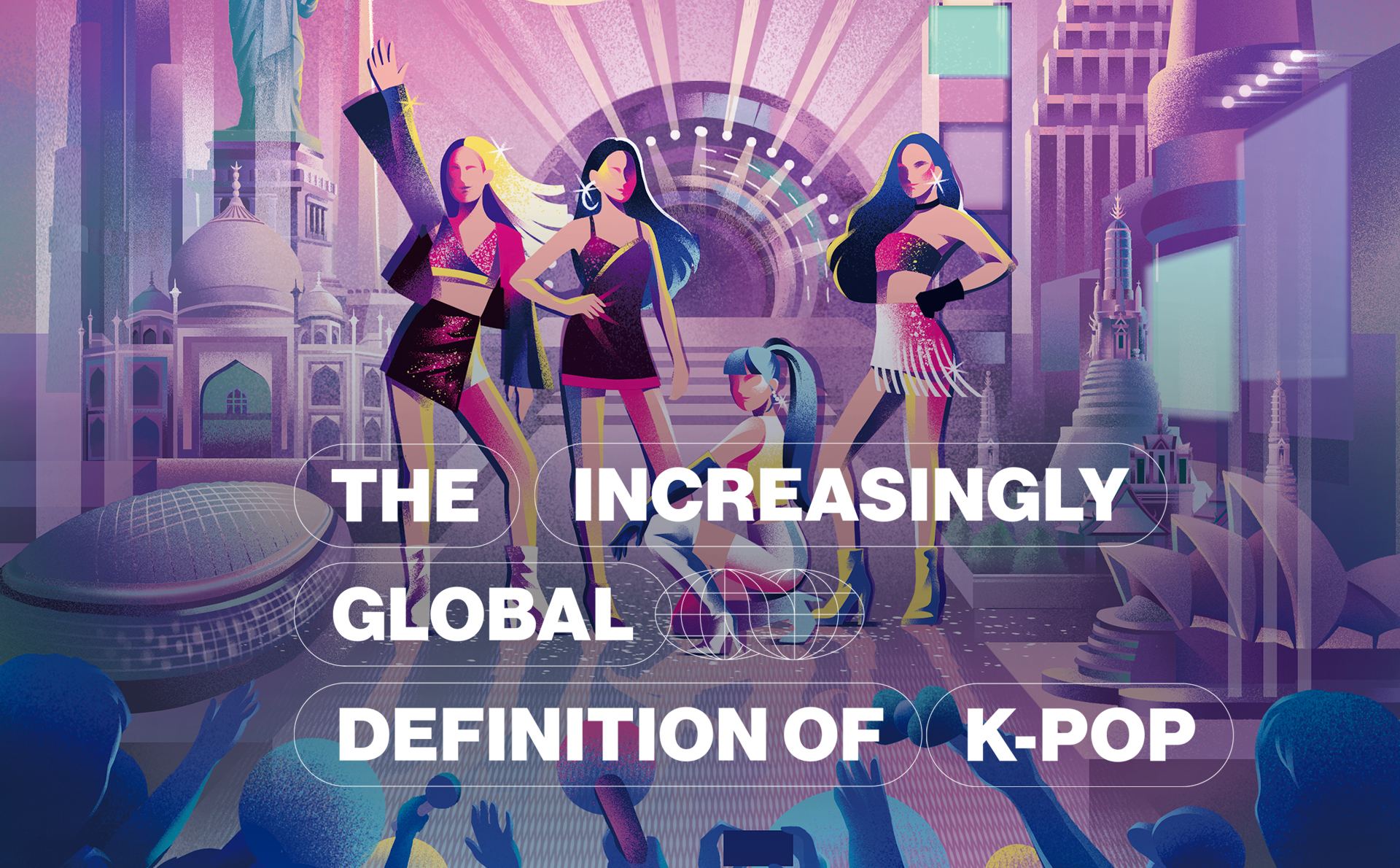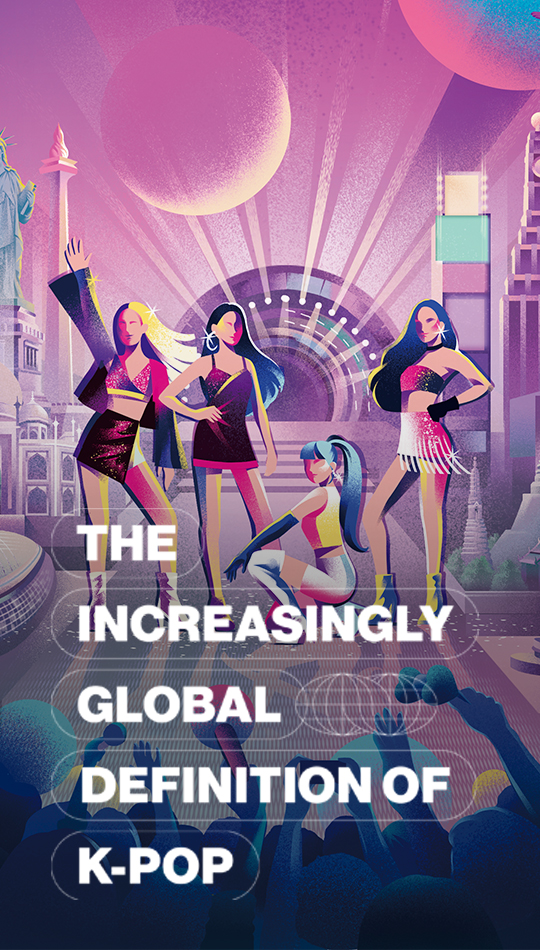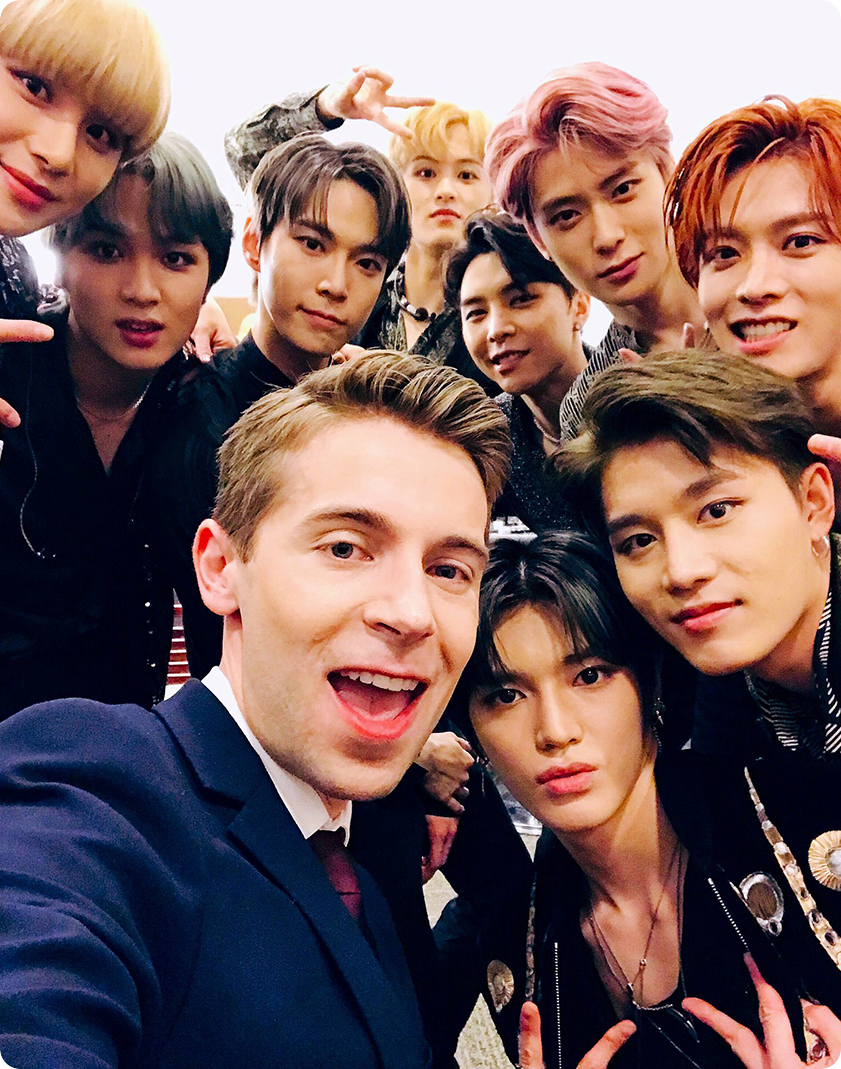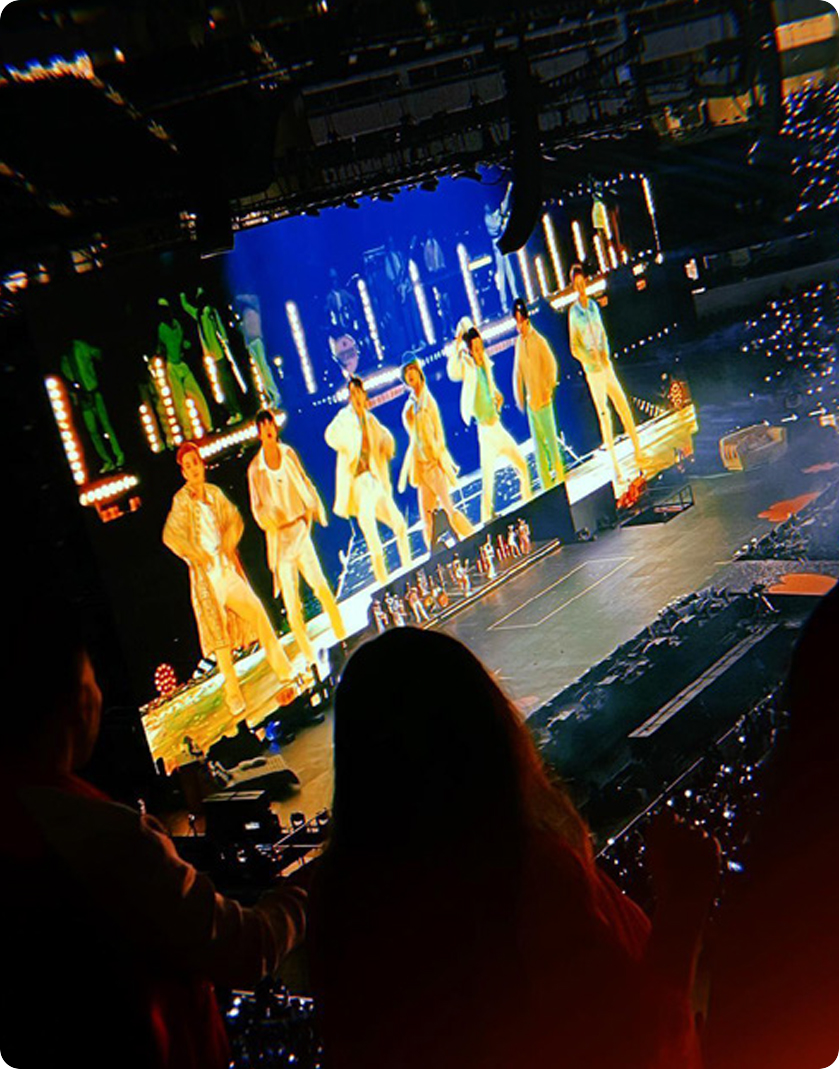Korea’s top entertainment companies like HYBE, JYP and SM Entertainment are expanding by teaming with international partners to create local acts with their savvy pop styling. This opens up the question of what exactly is K-pop and how has its definition changed in the last decade.


Writer.
Jeff Benjamin
Photography.
Jeff Benjamin
Illustration.
Mina.K
In early 2012, I had the distinctive honor of writing Rolling Stone magazine’s first-ever K-pop feature with a headline that seems almost silly today: “The 10 K-Pop Groups Most Likely to Break in America.” At the time this article was published, groups like BTS and BLACKPINK had not even existed yet, and Girls’ Generation’s “Gee” was the most viewed K-pop music video on YouTube with 74 million views. In fact, the piece came less than two months before PSY’s “Gangnam Style” music video would soon not only surpass “Gee” as YouTube’s most-watched K-pop video but soon take over the world as millions not only joined the rapper in his now-famous horsey dance but truly introduce the K-pop music scene on a global stage and prove the huge international potential of Korean artists and music.
The summer of PSY’s viral breakout was also a momentous year for me personally as I graduated college at New York University with a double major in journalism and music, watched the K-pop arena tours hit America when 2NE1 and BIGBANG performed concerts in the New York and Los Angeles areas, and even hosted 2NE1’s CL, Sandara Park, Park Bom and Minzy at Billboard’s studios for my first K-pop interview. In the decade since, I’ve not only continued to write about K-pop for Rolling Stone, but been lucky enough to have launched Billboard’s K-pop column at the top of 2013 while writing about the music scene for outlets like The New York Times, Forbes, and more, discussed Korean artists on platforms like CNN, MTV, and beyond, and was invited to different international conferences and festivals to connect K-pop to new audiences.
While it’s only been just over a decade, the definition of how I described K-pop then to now has changed in both exciting and intriguing ways. While readers of Rolling Stone in 2012 required an explanation of what K-pop is―and, by the most basic definition, is “Korean pop music”―today, artists like TWICE, SEVENTEEN, Stray Kids and NewJeans regularly decorate its website and magazine covers. This has all led me to realize that even as K-pop’s presence and mainstream acceptance have grown globally, the definition of K-pop today is more complicated than ever.
 In 2014, 2NE1's interview for their second full-length album 'CRUSH’ © Diana Levine
In 2014, 2NE1's interview for their second full-length album 'CRUSH’ © Diana Levine
K-pop’s Defining
Features
To understand the core of K-pop, there are some key features I tend to identify as a base. First of all, the multifaceted nature of K-pop releases is a cornerstone of the genre and what I believe is its success in garnering deep fan support. K-pop albums are conceptualized as all-encompassing projects. These releases go beyond mere collections of songs; they incorporate cohesive themes that permeate every aspect, from music and choreography to fashion and overarching messages. Fans are intrigued not only by the music and performances but also by the larger themes the artist represents in their projects. A first-generation K-pop group like H.O.T. from the ’90s helped mold this idea with the group (whose name stood for “Highfive Of Teenagers”) sharing songs on hit albums like “We Hate All Kinds of Violence” and “Wolf and Sheep” touching on young people’s experiences with school, bullying and self-discovery.
But also the release strategy in K-pop is a departure from the dominating Western norm, challenging the traditional model of singles leading up to a full album. Instead, K-pop artists generate anticipation by announcing projects with about a month of notice and keep the excitement high for the entire promotional period. A month of teasers culminates into the simultaneous release of the new music, single, music video and full album. The first live performance of the new music tends to happen within 24 hours of the album release as well. This strategy not only sustains fan interest and excitement in music and media’s quickly moving digital spaces but also lets artists make comebacks with multiple music releases a year, fostering an even more dynamic and engaging relationship with their audience.
The industry parameters further distinguish K-pop from other genres or music scenes. Oftentimes, potential K-pop singers are scouted either by the label or through auditions, and meticulously trained under an agency. The emphasis on training is critical, as artists are considered ready for debut only when they can embody the idealized image of “idols” with top-notch singing and performance skills. Media training is also an integral part of their development, preparing them to navigate formal interviews and public appearances effectively.

K-pop’s Current
& Future Trends
Looking ahead, the future of K-pop is marked by notable trends that indicate its continued evolution. Over the past decade, the genre has expanded beyond Korean borders, welcoming artists from Japan, China, Thailand, Australia, New Zealand, and the U.S. In recent years, this expansion has become more diversified with artists from Vietnam, Indonesia, the Philippines, India, Brazil, Spain, the U.K., and beyond joining the K-pop wave. While initial experiments have yielded mixed results so far, top entertainment companies like JYP Entertainment, HYBE, and SM Entertainment are now actively pursuing globalization initiatives.
Home to artists like 2PM, TWICE, Stray Kids, ITZY and NMIXX, JYP Entertainment’s collaboration with Republic Records for A2K (which stands for America to Korea) exemplifies this trend, creating a global girl group, VCHA, with the six members’ diverse backgrounds ethnically representing the U.S., Korea, Spain, Laos, Canada, Cuba, Vietnam, Venezuela, and Trinidad and Tobago. The group has already proved their high-powered stage skills by performing on shows like KBS’ Music Bank and MBC’s Show! MusicCore in 2023 alongside top K-pop acts and is set to make their official debut in 2024.
Meanwhile, HYBE (home to the likes of BTS, SEVENTEEN, Zico, LE SSERAFIM and NewJeans) teamed with Geffen Records for their Dream Academy survival show that created another six-member girl group, KATSEYE, with the members hailing from America, Korea, Switzerland and the Philippines set to debut in 2024. Plus, SM Entertainment (who houses artists like BoA, TVXQ!, Girls’ Generation, NCT and aespa) has also teamed with a television production company in the U.K. to co-produce a boy band for the British market.
These projects underscore the notion that K-pop’s appeal transcends ethnicities and geo-graphical boundaries. The collaboration between U.S. and Korean entertainment powerhouses illustrates a concerted effort to redefine K-pop as a global phenomenon, proving that it is not confined to a specific look, ethnicity, or style. Further illustrating the industry’s commitment to diversifying the K-pop landscape through localization, these companies are showing how the K-pop style and teachings can be embraced and recognized worldwide.
 Jeff and NCT 127
Jeff and NCT 127 BTS’s 2021 concert ‘Permission to Dance on Stage’ in Los Angeles
BTS’s 2021 concert ‘Permission to Dance on Stage’ in Los AngelesWho Should the
World Watch Next?
Among the many emerging K-pop artists, several groups stand out as promising additions to the ever-expanding K-pop universe.
HYBE LABELS JAPAN’s first-ever group &TEAM, a nine-member boy group with diverse cultural backgrounds representing Korea, Japan, Taiwan and Germany, showcases exciting potential. Notable hitmakers such as HYBE chairman “Hitman” Bang Si-Hyuk and Ryan Tedder of OneRepublic have contributed to their albums. Also, JYP’s NiziU and NEXZ, with their multicultural approach to releasing music in Japanese, Korean and English, require one’s attention after garnering impressive results like NiziU earning the Number One spot on a K-pop music program aired in Korea marking the first time a group entirely of non-Koreans was able to pull off such a feat.
HORI7ON, a seven-member Filipino group under MLD Entertainment (who created MOMOLAND and currently houses the groups TFN and Lapillus), has impressive K-pop songs. Additionally, many people are closely watching Japanese girl group XG, based in Korea and singing in English, with the group exemplifying the recognition other countries have for building a fanbase similar to K-pop groups.
But ultimately, amidst the global expansion and experimentation, the essence of any great artist lies in their ability to express authenticity.
BTS, the trailblazing, record-setting, Grammy-nominated group, exemplified this by not only showcasing their talents but also sharing their stories, inspirations, and unique worldviews. The ability to connect with fans on a personal level transcends industry dynamics and label promotions. Current K-pop leaders like Stray Kids, ATEEZ, LE SSERAFIM, IVE, and NewJeans continue to impress by opening up about their journeys and connecting with fans in genuine ways. The future narratives of artists like EN HYPEN, P1Harmony, EPEX, Paul Blanco, Lee Youngji, xikers, Kiss of Life, RIIZE, QWER and more hold the promise of further enriching the K-pop landscape.
As the genre continues to break barriers and redefine global music standards, it is the artists who share their authentic stories that will resonate most profoundly, ensuring the enduring appeal and impact of K-pop on the world stage. That is something I felt when I began my personal K-pop journey over a decade ago and feel more strongly about than ever today.

Jeff Benjamin
K-Pop Columnist at Billboard
Jeff Benjamin is an award-winning reporter acting as Billboard’s K-Pop columnist since 2013, breaking stories with J.Y. Park, PSY, BIGBANG, Girls’ Generation, CL, BTS, TWICE, SEVENTEEN, BLACKPINK, NewJeans and many more during his time so far. Beyond writing, Jeff joined as an international cast member and host for the 2019 K-pop variety show “We K-pop” filmed in Korea and aired weekly to more than 100 million viewers in 120 countries. In 2020, the Corea Image Communication Institute recognized him with the Korea Image Stepping Stone Bridge Award for “his contribution to introducing K-pop artists to the world.”
